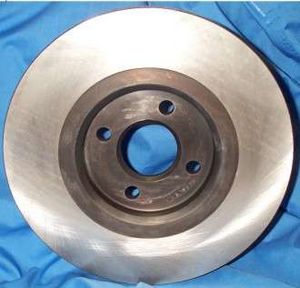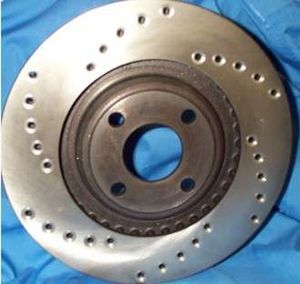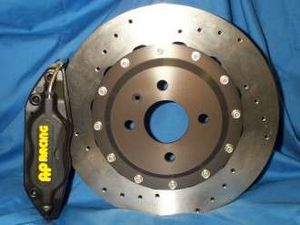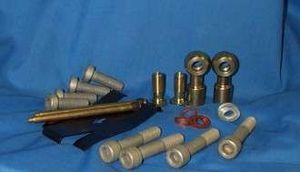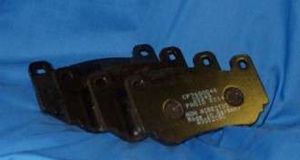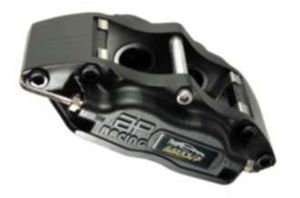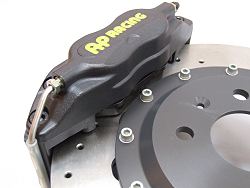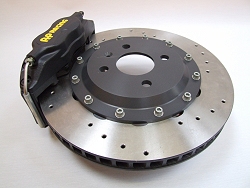Difference between revisions of "Brake discs"
| Line 2: | Line 2: | ||
===S1 Elise=== | ===S1 Elise=== | ||
====MMC==== | ====MMC==== | ||
| − | When originally conceived and released, the Elise was supplied with Metal Matrix Composite (MMC) brake | + | When originally conceived and released, the Elise was supplied with Metal Matrix Composite (MMC) brake discs in combination with specific MMC brake pads. In general it is agreed that an MMC brake setup provides excellent brake performance and feel. The only real complaint seems to be that in wet weather the initial bite and performance is poor until the discs are dried by application. (From VIN 2260 a splash guard was introduced to reduce this problem - Source [http://www.elises.co.uk elises.co.uk]) |
| − | MMC's differ from normal 'iron' | + | MMC's differ from normal 'iron' discs in that the friction generated is mostly Adherent Friction rather than abrasive friction (a very good article on the nature of braking can be found [http://www.stoptech.com/tech_info/wp_warped_brakedisk.shtml here]). Essentially when the disc and pad come in contact some of the pad material transfers onto the disc surface, meaning the contact patches between the two are effectively the same material. As the disc rotates the bonds between the surfaces break and reform creating friction. |
| − | One of the benefits of Adherent Friction is that under normal use the | + | One of the benefits of Adherent Friction is that under normal use the discs last a very very long time. When braking the pads transfer their material to the surface of the disc, and it is this layer that is broken down, not the disc suface. Therefore the discs suffer very little wear. Under very heavy use however, the bonds between the pad and disc cannot reform as fast as they are broken down, meaning areas of the disc can loose the material layer entirely. When this happens the abrasive friction of the pad can score away the disc surface making it too rough to rebuild the original material layer. If this happens braking performance from the disc is permanently damaged and the disc must be replaced. For this reason car used on track or running semi-slick tyres may wish to use traditional setups. |
| + | |||
| + | MMC discs were also extremely light, reducing the unsprung weight of each wheel. | ||
| + | |||
| + | MMC brake systems were supplied up until VIN 3714, when increased part costs forced Lotus to introduce standard iron brake discs. Recently Lotus have had trouble sourcing replacement pads, and have offered discounted conversions to iron discs for affected customers. Third party replacement pads are available from [http://www.eliseparts.com Elise Parts] and [http://www.elise-shop.com Elise Shop]. These alternative pads are also said to improve wet weather performance. MMC discs are no longer available. | ||
| − | |||
====Standard cast iron==== | ====Standard cast iron==== | ||
| − | + | These discs followed the MMC disc as the standard brake disc for the S1 Elise from VIN 3715. | |
| − | These discs followed the MMC disc as the standard brake disc for the S1 Elise. | + | |
| + | Although introduced for cost reasons, Iron disks are better able to withstand the high temperatures associated with track driving and provide better wet weather performance than the previous MMC disks. | ||
| − | + | The surface of the disks are solid, however they are internally vented to aid cooling. As the disk rotates at speed, centrifugal forces act on the air inside the vanes, forcing it outwards from the center. This action then draws fresh, cooler, air from the center of the disc through the internal vanes and out through the holes in the edges. | |
| + | extremely light, reducing the unsprung weight of each wheel. | ||
| + | (Lotus Part Number: A111J0128F) | ||
| − | + | [[Image:A111J0128F.JPG|thumb|left|Vented S1 OEM Disc]] | |
{{clr}} | {{clr}} | ||
| + | |||
====Cross drilled==== | ====Cross drilled==== | ||
| + | The Sport 135, Sport 160, Sport 190 and 111S models were supplied with iron disks which were vented and cross drilled. Cross drilling is the name given to drilling holes through the disc. This has a number of advantages: | ||
| + | * The holes allow for better cooling by drawing more air into the internal vanes. | ||
| + | * The edges of the holes clean pad surface which can provide increased brake 'bite'. | ||
| + | * The holes prevent gasses from collecting between the pad and disc surface | ||
| + | * The holes reduce the weight of the disk, and therefore its inertia and the unsprung weight. | ||
| + | |||
| + | (Lotus Part Number: A111J0141F) | ||
| + | |||
[[Image:A111J0141F.JPG|thumb|left|Cross drilled and Vented S1 Disc]] | [[Image:A111J0141F.JPG|thumb|left|Cross drilled and Vented S1 Disc]] | ||
| − | + | {{clr}} | |
| − | |||
| − | |||
===S1 Exige, 340R=== | ===S1 Exige, 340R=== | ||
| − | The Lotus Series 1 Exige | + | The Lotus Series 1 Exige and 340R, were fitted with the same cross drilled disks as seen on the Series 1 111s and Sport 160 editions described above. |
| + | (Lotus Part Number:A111J0141F) | ||
| − | |||
| − | ===S2 Elise=== | + | ===S2 Elise and Exige=== |
| − | 288mm | + | Series 2 Elises are fitted with 288mm vented iron discs. |
| − | The disks on the S2 are | + | The disks on the S2 are not compatible with those used on the S1, although they are the same diameter the offset and venting is different. |
The S2 discs feature longer, curved internal flow passages which increase the disc stability and reduce hot spot formation. The revised hole pattern has been specified to complement the new vane arrangement. | The S2 discs feature longer, curved internal flow passages which increase the disc stability and reduce hot spot formation. The revised hole pattern has been specified to complement the new vane arrangement. | ||
The discs are not handed, so the same disc is used on the right and left hand sides of the car. The cooling air flow through the left and right discs is identical and the flow rate is purely a result of pressure differential between the centre of the disc and its rim; the shape of the vanes and the direction of rotation does not affect the flow rate significantly. | The discs are not handed, so the same disc is used on the right and left hand sides of the car. The cooling air flow through the left and right discs is identical and the flow rate is purely a result of pressure differential between the centre of the disc and its rim; the shape of the vanes and the direction of rotation does not affect the flow rate significantly. | ||
| + | |||
Some noise from the brakes themselves is to be expected but there is a fix to stop brake pads banging in the callipers. | Some noise from the brakes themselves is to be expected but there is a fix to stop brake pads banging in the callipers. | ||
| − | |||
| − | |||
| − | |||
===Vaxuall VX200=== | ===Vaxuall VX200=== | ||
| + | Content yet to be added! Are the VX disks the same as the S1/S2? Press the 'Edit' link to add your knowledge! | ||
| − | |||
| − | |||
| − | |||
| − | |||
| − | |||
| − | |||
| − | |||
| − | |||
| − | |||
| − | |||
==Lotus Europa Disc Brakes== | ==Lotus Europa Disc Brakes== | ||
| Line 62: | Line 64: | ||
288mm Vented Discs with [http://en.wikipedia.org/wiki/Anti-lock_braking_system ABS] | 288mm Vented Discs with [http://en.wikipedia.org/wiki/Anti-lock_braking_system ABS] | ||
| − | + | This is currently unconfirmed - Press the 'Edit' link to add your knowledge! | |
| + | |||
==Elise Upgrade Options== | ==Elise Upgrade Options== | ||
| − | |||
| − | |||
| − | + | ===Lotus Motorsport=== | |
| − | |||
| − | |||
| − | + | ====Lotus Motorsport Brake Bias Valve==== | |
| − | + | Lotus Motorsport Brake Bias Valve, as used on the Elise S2 Sport 190 and VX220 Sprint. This allow the front/rear brake balance to be adjusted. | |
| − | as used on the Elise S2 Sport 190 and VX220 Sprint. | + | (Lotus Part Number:ALS1J6012F) |
| − | |||
| + | [[Image:brakebias.JPG|thumb|left|Lotus Motorsport Brake Bias Valve]] | ||
| + | {{Clr}} | ||
| − | Lotus Motorsport | + | ====Lotus Motorsport Brake Master Cylinder==== |
| + | (Lotus Part Number:ALS1J6010F) | ||
| + | Content to be added! Press the 'Edit' link to add your knowledge! | ||
| − | + | ====Lotus Offical upgrade kit for the S2==== | |
| − | |||
| − | |||
| − | |||
| − | |||
| − | ==Lotus Offical upgrade kit for the S2== | ||
| − | |||
Lotus Motorsport supplied bolt on kit that comes with 2 x AP 4 pot alloy calipers with Pagid RS14 Pads and 2 x alloy bells with discs. | Lotus Motorsport supplied bolt on kit that comes with 2 x AP 4 pot alloy calipers with Pagid RS14 Pads and 2 x alloy bells with discs. | ||
| + | (Lotus Part Number:ALS3J0040F) | ||
| − | + | From Lotus Motorsport: | |
| − | Track Use Only | + | Fittings are also included. |
| + | Track Use Only | ||
| + | |||
| + | The pads are 16mm thick with an area of 43.2cm2 and are Pagid RS14 ceramic friction material. | ||
| + | |||
| + | They are full race pads with a medium to high friction value. | ||
| + | |||
| + | The discs are 310mm outside diameter and 28mm thick and weigh 4.9kg | ||
| + | |||
| + | The Caliper is a 2 piece aluminium alloy body with 38.10mm diameter piston bores. Weight is 2.3kg | ||
| + | |||
| + | Designed to fit the following cars using a 16inch Front wheel: | ||
| + | |||
| + | - Elise S2 (with OZ wheels + 3mm spacer) | ||
| + | - Elise 111R - with Exige S2/Forged Alloy wheels | ||
| + | - Exige S2 - direct fitment | ||
| + | |||
| + | This kit will not fit Elise S1 or Exige S1. | ||
| + | |||
| + | Lotus recommend use with braided brake hoses | ||
| + | |||
| + | Lotus Part Number:ALS3J0040F | ||
| + | |||
| + | Price £1,762.50 inc VAT | ||
| + | [[Image:brakeupgrade1.JPG|thumb|left|Upgrade Caliper and Discs]][[Image:brakeupgrade2.JPG|thumb|left|Upgrade bolts]][[Image:brakeupgrade3.JPG|thumb|left|Upgrade Pads]][[Image:ALS1J6002_3F.JPG|thumb|left|Lotus Motorsport AP 4 Pot Calipers ]][[Image:APBigBrakeCaliper.jpg|thumb|left|Upgrade Caliper]][[Image:APBigBrakeCaliper2.jpg|thumb|left|Upgrade Caliper and Disc]] | ||
| + | {{Clr}} | ||
| − | |||
| − | + | ===EliseParts.com=== | |
| + | [http://www.eliseparts.com/shop/index.php?main_page=index&cPath=157&zenid=a2860acbb2e0d419982d9d1196ced354 Elise Parts] | ||
| − | |||
| − | + | ===Plans Motorsport=== | |
| − | [ | + | [http://www.plansmotorsport.com/showroom/components/ Plans Motorsports] |
| + | ==Common Questions== | ||
| + | ===Pads sticking to the disc=== | ||
| − | + | The unservoed brakes on the S1 were criticised for not having enough initial bite when first applied, so Lotus used higher "grab" pads on the S2 to improve this. A byproduct of these pads is they tend to stick to the disc over a period of time, in damp or humid conditions this can happen within a couple of hours. This is something that affects the S1 as well but not to the same extent. Normally the stiction is limited to a clunk on pulling away, but with wet weather or if the car has recently been washed, the stciking can be quite severe. This however is not a problem its just Something you just need to be aware of, it is also just another case of [http://wiki.seloc.org/index.php/TADTS TADTS] | |
| − | |||
| − | |||
| − | |||
| − | |||
| − | |||
| − | |||
| − | |||
| − | |||
| − | |||
| − | |||
| − | |||
| − | |||
| − | |||
| − | |||
| − | |||
| − | |||
| − | |||
| − | |||
| − | |||
| − | |||
| − | |||
| − | |||
| − | |||
| − | |||
| − | |||
| − | |||
| − | |||
| − | |||
| − | |||
| − | This | ||
| − | |||
| − | |||
| − | |||
| − | |||
| − | |||
| − | |||
| − | |||
| Line 158: | Line 144: | ||
[http://www.hubert.racegame.org/brakes.html HubSpace.net on Disc Brakes] | [http://www.hubert.racegame.org/brakes.html HubSpace.net on Disc Brakes] | ||
| − | + | The "Warped" Brake Disc and Other Myths of the Braking System by Carroll Smith: http://www.stoptech.com/tech_info/wp_warped_brakedisk.shtml | |
| − | by Carroll Smith | ||
Revision as of 23:06, 18 August 2006
Lotus OEM Fitment
S1 Elise
MMC
When originally conceived and released, the Elise was supplied with Metal Matrix Composite (MMC) brake discs in combination with specific MMC brake pads. In general it is agreed that an MMC brake setup provides excellent brake performance and feel. The only real complaint seems to be that in wet weather the initial bite and performance is poor until the discs are dried by application. (From VIN 2260 a splash guard was introduced to reduce this problem - Source elises.co.uk)
MMC's differ from normal 'iron' discs in that the friction generated is mostly Adherent Friction rather than abrasive friction (a very good article on the nature of braking can be found here). Essentially when the disc and pad come in contact some of the pad material transfers onto the disc surface, meaning the contact patches between the two are effectively the same material. As the disc rotates the bonds between the surfaces break and reform creating friction.
One of the benefits of Adherent Friction is that under normal use the discs last a very very long time. When braking the pads transfer their material to the surface of the disc, and it is this layer that is broken down, not the disc suface. Therefore the discs suffer very little wear. Under very heavy use however, the bonds between the pad and disc cannot reform as fast as they are broken down, meaning areas of the disc can loose the material layer entirely. When this happens the abrasive friction of the pad can score away the disc surface making it too rough to rebuild the original material layer. If this happens braking performance from the disc is permanently damaged and the disc must be replaced. For this reason car used on track or running semi-slick tyres may wish to use traditional setups.
MMC discs were also extremely light, reducing the unsprung weight of each wheel.
MMC brake systems were supplied up until VIN 3714, when increased part costs forced Lotus to introduce standard iron brake discs. Recently Lotus have had trouble sourcing replacement pads, and have offered discounted conversions to iron discs for affected customers. Third party replacement pads are available from Elise Parts and Elise Shop. These alternative pads are also said to improve wet weather performance. MMC discs are no longer available.
Standard cast iron
These discs followed the MMC disc as the standard brake disc for the S1 Elise from VIN 3715.
Although introduced for cost reasons, Iron disks are better able to withstand the high temperatures associated with track driving and provide better wet weather performance than the previous MMC disks.
The surface of the disks are solid, however they are internally vented to aid cooling. As the disk rotates at speed, centrifugal forces act on the air inside the vanes, forcing it outwards from the center. This action then draws fresh, cooler, air from the center of the disc through the internal vanes and out through the holes in the edges. extremely light, reducing the unsprung weight of each wheel. (Lotus Part Number: A111J0128F)
Cross drilled
The Sport 135, Sport 160, Sport 190 and 111S models were supplied with iron disks which were vented and cross drilled. Cross drilling is the name given to drilling holes through the disc. This has a number of advantages:
- The holes allow for better cooling by drawing more air into the internal vanes.
- The edges of the holes clean pad surface which can provide increased brake 'bite'.
- The holes prevent gasses from collecting between the pad and disc surface
- The holes reduce the weight of the disk, and therefore its inertia and the unsprung weight.
(Lotus Part Number: A111J0141F)
S1 Exige, 340R
The Lotus Series 1 Exige and 340R, were fitted with the same cross drilled disks as seen on the Series 1 111s and Sport 160 editions described above. (Lotus Part Number:A111J0141F)
S2 Elise and Exige
Series 2 Elises are fitted with 288mm vented iron discs.
The disks on the S2 are not compatible with those used on the S1, although they are the same diameter the offset and venting is different.
The S2 discs feature longer, curved internal flow passages which increase the disc stability and reduce hot spot formation. The revised hole pattern has been specified to complement the new vane arrangement.
The discs are not handed, so the same disc is used on the right and left hand sides of the car. The cooling air flow through the left and right discs is identical and the flow rate is purely a result of pressure differential between the centre of the disc and its rim; the shape of the vanes and the direction of rotation does not affect the flow rate significantly.
Some noise from the brakes themselves is to be expected but there is a fix to stop brake pads banging in the callipers.
Vaxuall VX200
Content yet to be added! Are the VX disks the same as the S1/S2? Press the 'Edit' link to add your knowledge!
Lotus Europa Disc Brakes
288mm Vented Discs with ABS
This is currently unconfirmed - Press the 'Edit' link to add your knowledge!
Elise Upgrade Options
Lotus Motorsport
Lotus Motorsport Brake Bias Valve
Lotus Motorsport Brake Bias Valve, as used on the Elise S2 Sport 190 and VX220 Sprint. This allow the front/rear brake balance to be adjusted. (Lotus Part Number:ALS1J6012F)
Lotus Motorsport Brake Master Cylinder
(Lotus Part Number:ALS1J6010F) Content to be added! Press the 'Edit' link to add your knowledge!
Lotus Offical upgrade kit for the S2
Lotus Motorsport supplied bolt on kit that comes with 2 x AP 4 pot alloy calipers with Pagid RS14 Pads and 2 x alloy bells with discs. (Lotus Part Number:ALS3J0040F)
From Lotus Motorsport:
Fittings are also included. Track Use Only The pads are 16mm thick with an area of 43.2cm2 and are Pagid RS14 ceramic friction material. They are full race pads with a medium to high friction value. The discs are 310mm outside diameter and 28mm thick and weigh 4.9kg The Caliper is a 2 piece aluminium alloy body with 38.10mm diameter piston bores. Weight is 2.3kg Designed to fit the following cars using a 16inch Front wheel: - Elise S2 (with OZ wheels + 3mm spacer) - Elise 111R - with Exige S2/Forged Alloy wheels - Exige S2 - direct fitment This kit will not fit Elise S1 or Exige S1. Lotus recommend use with braided brake hoses Lotus Part Number:ALS3J0040F Price £1,762.50 inc VAT
EliseParts.com
Plans Motorsport
Common Questions
Pads sticking to the disc
The unservoed brakes on the S1 were criticised for not having enough initial bite when first applied, so Lotus used higher "grab" pads on the S2 to improve this. A byproduct of these pads is they tend to stick to the disc over a period of time, in damp or humid conditions this can happen within a couple of hours. This is something that affects the S1 as well but not to the same extent. Normally the stiction is limited to a clunk on pulling away, but with wet weather or if the car has recently been washed, the stciking can be quite severe. This however is not a problem its just Something you just need to be aware of, it is also just another case of TADTS
Other sources of information
Elises.co.uk on S1 Disc Brakes
Elises.co.uk on S2 Disc Brakes
The "Warped" Brake Disc and Other Myths of the Braking System by Carroll Smith: http://www.stoptech.com/tech_info/wp_warped_brakedisk.shtml
